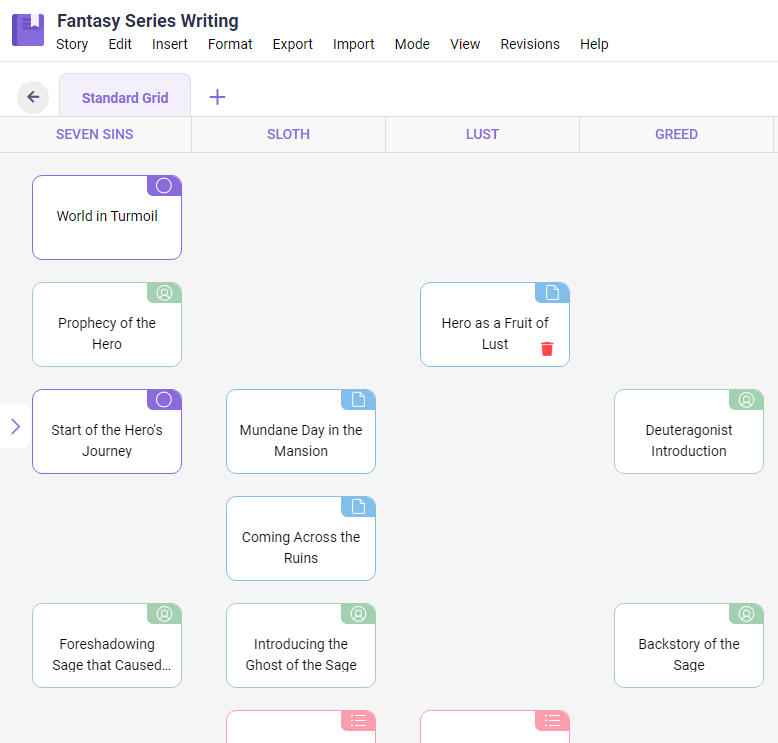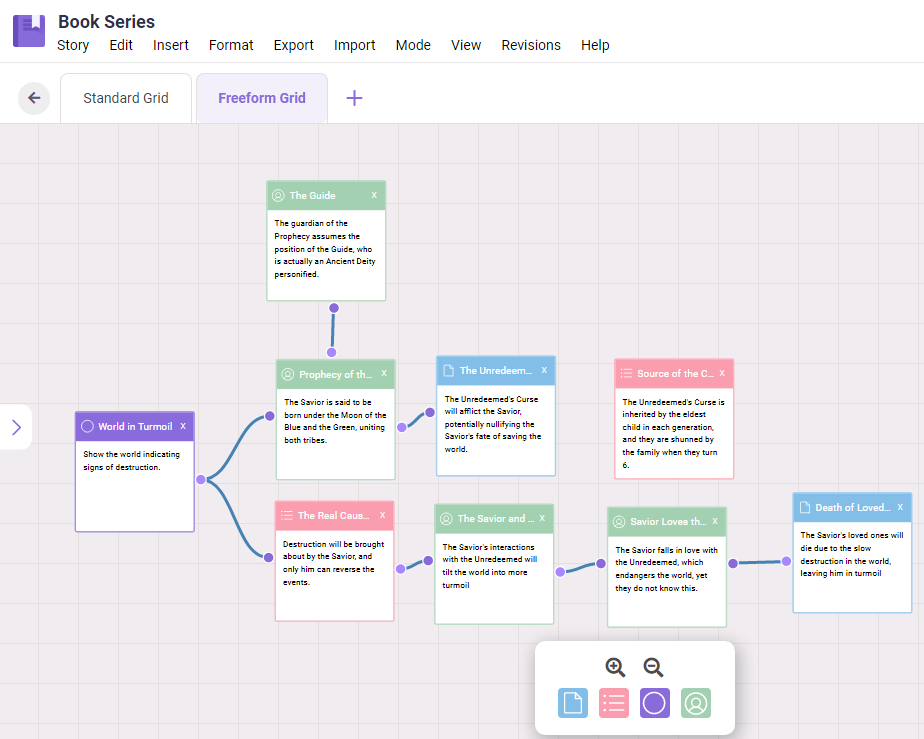How To Write a Series with LivingWriter

Writing a single book is hard work by itself, so it is understandable that entertaining the idea of writing a series of books can be out of your league. However, writing a series of books can do wonders for you as an author, not least of all developing a loyal fanbase who would be looking forward to your next releases.

However, we are not going to sugarcoat the heavy lifting you have to do to finish a task as gargantuan as writing a series of books. What we can do is offer you insightful advice and important tips that will help ease the burden of writing multiple books. It’s not going to be an easy job, nor is it going to be a short one. We can tell you, though, that it is going to be a good one.
We’ll also tell you about the powerful tools that LivingWriter has in its arsenal to make writing a series of books as smooth-sailing and convenient as possible.
Why Write a Series?

Aside from your own story ideas compelling you to write more than a single novel, writing a series can be good for you as an author. First and foremost, a series of books means that most, if not all, of the books will guarantee increased sales. With more books to sell, you also earn more as an author, and each book, if written well, will sell as much as the others.
Another benefit is the easy marketability of your books. The mere fact of your novels being part of a series can be enough promotion to sell all of them in one go to your readers. As part of a series, these novels will feel incomplete (although we will emphasize later on that they should be standalone novels in their own right) without the others, so naturally readers will also want them.

Perhaps the best and most important advantage of writing a series of books is that it can easily capture a loyal fanbase. Since readers have spent a lot of time following the adventures and tribulations of your cast of lovable, relatable, and complex characters, they are more likely to closely follow you as an author, and they may even follow you beyond the series.
Writing a series of books can be time-consuming, and for some it may even become their life-long labor of love, but the benefits it gives you as an author are nothing short of astounding.
Now let’s get into the nitty-gritty of writing your books (PLURAL)!
The Feasibility of a Series of Books
Of course, before we even deal with the technicalities on how to write a series, we need to make sure that your story idea is solid enough to sustain itself for at least more than one novel. It should have enough content that is too much for a single book; the idea itself should demand it to be written into a series.
What this means is that your story’s overarching plot is large enough that its own subplots can stand as individual novels themselves. Most of the time, the timeline of your plot can be a good indication. If the start and end of your plot covers years, if not decades, then you can break up those long years into separate novels.
Determining the Series by Genres

One consideration that you will want to look into is the genre that you are writing into. The fantasy and science fiction genres are the best genres to write a series about, since the sheer existence of a new, separate world will often demand multiple books to explore its systems and machinations. As the reader goes through the series, they learn more not just about the development of the characters, but also of the world that the characters are in.

On the other hand, the mystery genre will often follow the adventures of an inspector figure in solving mysteries, such as the likes of Sherlock Holmes. Episodic novels are a go-to for this genre, having a looser timeline and thus each book can stand on its own without needing to read the previous one. For stories which fixate themselves on the chronicles of a single, often static (yet not wholly unchanging), character embarking on different journeys, an episodic series can make a lot of sense.

However, for other genres, you might instead opt for an even looser type of series. Any genre can utilize having multiple stories written in the same universe. In this type of series, multiple books share only the same settings (and more often, themes), yet they exist in separate timelines. Although some stories can have some overlap, most of the time these stories will have quite a time gap between them, often to emphasize the recurring themes of the story in the background of a similar yet distinctively different environment.
In the end, your plot will decide this all for you. Are you going to tell the story of a world of myths and magic, or of the comical misadventures of an especially unlucky man, or of two sets of friendships of different eras sustaining amidst all adversity?
Plan Your Series
Planning Your Plot
If you want to really write a series of books, you also want to acknowledge that you are going to plan things in your plot, albeit loosely at this point, as in an architect-writer’s way. Planning is perhaps more important to fantasy and science fiction series as you have to know, at the very least, your starting and ending points of your overarching plot.

By determining your overarching plot, you have a guide for your individual novels in the series. Each book should, in some way, push the plot closer to the climax of your overarching plot while also finishing up its own plot. If you can manage to make an outline for your overarching plot, then that’s even better.
Part of the planning phase would be the identification of the recurring themes that you would want to emerge in each of your books. However, sometimes themes don’t show up immediately this early in the writing process. It’s great to note that as part of a series, these books should also share similar themes.
For plots and outlines of multiple plotlines, LivingWriter comes in strong with its new addition, the Plot Board. The Plot Board comes in two varieties, the Standard Grid and the Freeform Grid. In planning out your overarching plot, we recommend that you use the Standard Grid. The Standard Grid allows you to view all your plotlines in a tabular grid, with each column representing a unique plotline.

If you have a clear vision of how the overarching plot would develop, you can place each Plot Point in one plotline, appropriately named the Overarching Plot or any similar variation. Then, you can add new plotlines, one for each book, perhaps, then detail their own Plot Points in the plotline.
The Standard Grid is a great way to visualize the flow of events in your entire series, and see how the plotlines in your series of books would interconnect and weave together to form the grand narrative of your main plot.
If you feel like your plot is too complex to be documented in a linear fashion as in the Standard Grid, then the Freeform Grid will allow you to create mind maps, which can connect multiple Plot Points together in a freeform space.

Planning the Other Aspects of your Series
For episodic series and stories existing in the same universe, the planning does not cover the entirety of the series. Instead, you would like to have a concrete idea of the recurring main character or the recurring setting. You want to have a comprehensive character profile for your primarily static main character, describing their physical appearance, prominent characteristics and other pertinent information.

You should note that in order for static characters to succeed, they should be as interesting and compelling as possible, making character profiles even more important. Your main character will be the glue of the entire series, and so their personality should be refreshing enough that people would continue to read their adventures despite them not changing in any major way.
In designing the setting upon which your stories will take place, you not only have to detail the description of the world, but also the changes that this world will undergo that will affect the stories in your series. Since series of this nature often have large time gaps between each novel, you have to compare and contrast the world from the older novel to the newer story. This can help emphasize the recurring themes that you would want to emerge from the entire series.

If you are planning characters, world systems, or the entire setting itself, then LivingWriter also got you covered. Story Elements allows you to comprehensively describe a character, from nickname to relationships, and even have a visual inspiration by adding images to each element. You can have sections of notes for each Story Element, allowing you to detail them as much as you want.

The best part of Story Elements is its tight integration with the manuscript. Any time you mention a Story Element in the document, LivingWriter automatically identifies that Story Element and will pull up your notes about that specific element. You can easily access all your notes right at the sidebar of the document, without having to look through all your notes.

Explore Your Fictional World
Although we have already mentioned the description of the world and its systems before, we deem that this deserves a section by itself. No matter what type of series you plan to write, at least one thing will be common among all of them: the fact that they all occur in the same universe. While stories tied only by the same universe will no doubt explore the world in a chronological way (i.e. explore the changes over time in the world), for the other series, you would want to explore the world in both breadth and depth.

Multiple books mean multiple opportunities to inspect this special world that you have crafted for your characters. This process, called world-building, allows readers to be fully immersed in the fictional world. You can focus on different aspects of the world in every book, so that the reader will have a comprehensive view of the environment by the time they finish the series.
Aside from exploring the great fictional world, you should also reinforce recurring concepts, themes, and events to indicate consistency of the books existing in the same universe. By including some Easter eggs in the books, you can reward readers who notice these minor details, making the series more endearing to them.
Individuality of the Books
Although we have mentioned that each book in a book series should stand as an independent story by itself, we’d like to emphasize this point further. The individuality of the books should be present in both plot and character development.

The plot of a book should stand by itself, yet at the same point propel the overarching story forward. If you planned your overarching plot properly beforehand, you would notice that each book should deal with a specific problem or issue that needs to be resolved in order to reach the final climax. This issue should be big enough that it will warrant the development of its own set of events, with its own rising and falling action and climax. This climax, in particular, is usually the plot point that will move the overarching plot forward.
On the other hand, your characters should also exhibit changes in each novel. Although episodic novels may not change their main character as much, there should still be a bit of distinction between the characters across the books. The character development for your main set of characters should happen naturally over the course of the series. With the span of a long series, you can even explore the development of secondary characters.

Having a separate cast of secondary characters for each book can also enhance the individuality of the book. A fresh cast of characters will change the dynamics of the characters in the novel, and maybe even introduce an entirely different set of challenges and issues that will also need to be overcome.
The important thing to note is that each novel in a book series is still a novel by itself. Give it the same treatment as you would with a single book, and you’ll be well on your way to writing them well.
Create Patterns in Titles
What makes book series fun to look at is their apparent connection to each other right at the title itself. We can take a look on the book titles of popular book series today for reference:
- Veronica Roth’s Divergent, Insurgent, Allegiant
- George R.R. Martin’s A Game of Thrones, A Clash of Kings, A Storm of Swords, A Feast for Crows, A Dance with Dragons
- Mervyn Peake’s Titus Groan, Gormenghast, Titus Alone
You can see that in every series, there seems to be a pattern in them. Veronica Roth opted for a rhyming pattern, while A Song of Ice and Fire exhibits a consistent “A (noun) (preposition) (noun).” Although this is by no means a requirement or an indication of possible success (the Harry Potter series and the Percy Jackson series only have their eponymous main characters’ names as the only consistent part of the novel names), it can be a fun exercise for you to derive these names for your books.
Write a Series of Books with LivingWriter
This guide is only for the overarching series of books. All tips about writing a book will apply to each individual novel, and even so, you’ll find that LivingWriter is flexible and powerful enough to handle not just single manuscripts but also entire series of books. You can even explore more of LivingWriter’s features that we haven’t discussed here and be pleasantly surprised that LivingWriter is truly a great writing companion for authors.
Try LivingWriter now!